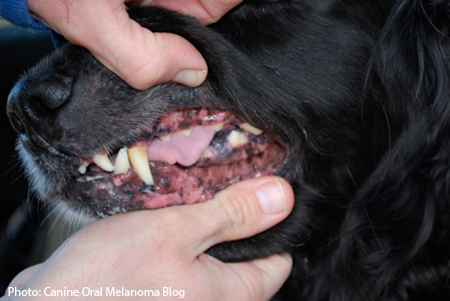Melanoma Monday for Dogs

Melanoma Monday for Dogs
May is a busy month, cancer-wise. May has been designated as Skin Cancer Awareness Month and, more specifically, the first Monday in May is Melanoma Monday. Skin cancer is much less common in pets than in people, in part because most pets avoid tanning booths and prefer not to sunbathe. But dogs do develop malignant melanomas in their oral cavity or on their toes. In these locations, melanoma can be as deadly in dogs as it is in humans. The good news about canine melanoma is that treatment options are available to veterinary cancer specialists and these options can be tailored to your dog’s specific needs. The decision in favor or against various treatment options for melanoma depend on the location of the tumor, the extent of the tumor throughout the body and, based on a biopsy, how likely the tumor is to spread.
Surgery
Surgical removal of a melanoma serves a dual purpose – diagnosis and treatment. Removal of the melanoma is an important first step in treating the cancer. For melanoma of the toe, surgery can easily remove the toe and the tumor, resection of melanoma in the oral cavity is less simple. In the process of removing the melanoma, tissue from the tumor is submitted for a biopsy to confirm the diagnosis. Surgery may also be used to sample lymph nodes in the region of the tumor to help determine how far the tumor has spread. The extent of the tumor dictates ongoing treatment needs.
Radiation Therapy
If an oral melanoma cannot be removed, radiation therapy has proven effective in shrinking these tumors. Radiation can also be implemented post operatively if tumor cells are discovered in the lymph node biopsy or if the oral biopsy shows a melanoma has been incompletely removed. Treatment of melanoma of the toe with radiation is uncommon, but not unheard of, since surgery is usually successful at removing the tumor.
Immunotherapy
Melanoma is the first veterinary cancer to have a specific immunotherapeutic agent developed for treatment of the disease. Most of us associate a vaccine with protection against disease, but the canine melanoma vaccine alerts the dog’s immune system to the presence of melanoma and starts an immune reaction against the melanoma cells. In clinical research, this vaccine has been shown to lengthen survival time in dogs with melanoma when the vaccine is administered after surgery or radiation therapy is performed to control the primary tumor. Immunotherapy agents have also been developed for human patients with melanoma.
Chemotherapy
Chemotherapy is probably the least commonly prescribed cancer treatment for dogs with melanoma. Veterinary oncologists have studied a few drugs in this disease, but no drug consistently shrinks these tumors and prolongs survival. Drugs most commonly considered for the treatment of melanoma in the dog include platinum-based drugs such as carboplatin, doxorubicin, lomustine and dacarbazine.
While it may be comforting to know, treatment options are available if your dog develops a melanoma. Identifying the tumor and quickly instituting therapy is still critical for long-term control of the tumor. Bad breath, oral bleeding, and toe swelling can all be signs of a melanoma in your dog. If you identify one of these signs, make an immediate trip to your veterinarian.

































